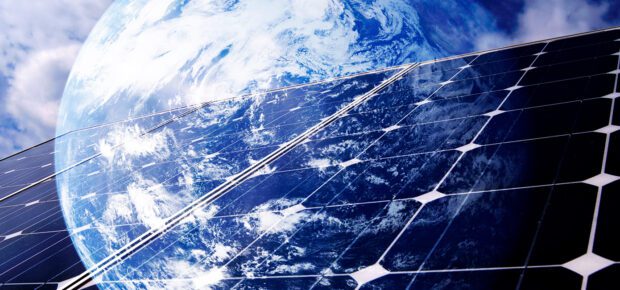April 27, 2023
It’s always sunny in outer space. Could that be a source of energy on earth?
Space-based solar arrays are a staple of science fiction – an idea that has ignited the imaginations of technologists and researchers for several decades. They involve vast arrays of orbiting solar panels that collect energy and beam it wirelessly to where it is needed.
Beyond sci-fi though, there are very real efforts to make space-based solar power (SBSP) a reality.
“There are very aggressive research programs related to this technology in several countries such as the United States, China, Japan, Russia, South Korea and India,” said Raul Colcher, IEEE Life Senior Member.
A bright future?
The CalTech Space Solar Power Project (SSPP) launched in early 2023 with a package of prototype components that could be used in orbital solar farms. China has plans for a station with commercial generation capacity as early as the 2030s.
The U.S. conducted research into orbital solar through the ‘70s when energy prices were high, but largely abandoned work on the issue in the early 2000s, because of a mix of financial and technical challenges. Two trends have renewed interest. The first is the drive toward net zero carbon emissions by 2050. Second is the distant possibility of a lunar base. SBSP could provide a source of power for vehicles and structures on a lunar base, especially in its critical early days.
Proponents say it has a couple of advantages, although implementation may still be decades away. If it ever comes to fruition, it could make solar power available at night or when it is cloudy, something that ground-based solar can’t do. About 30 percent of solar radiation never makes it to ground level. And then there’s the sheer scale of solar power: sunlight in space is abundant on scales that dwarf earth-based power sources.
“In space the sun is always shining, the tilt of the Earth doesn’t prevent the collection of power and there’s no atmosphere to reduce the intensity of the sun’s rays,” said IEEE Senior Member Inderpreet Kaur. “This makes putting solar panels into space a tempting possibility.”
Will they ever get off the ground?
Detractors point out the massive number of technological hurdles that must be overcome before such a project reaches feasibility: how to assemble solar arrays in space, how to transmit energy back to earth and how to launch materials into orbit in a cost-effective and energy-efficient manner.
“The idea for space-based solar arrays has been around for many years but the technical challenges are still there,” said IEEE Fellow Panagiotis Tsiotras. “I do not believe the economics work at the moment in terms of power efficiency, or the manufacturing and assembling of such large solar arrays. To make progress, advances in those areas are needed, as well as in materials.”

Igniting the Imagination
Still, prototypes are on the way and drawing lots of attention. One of CalTech’s experiments, called the Deployable on-Orbit ultraLight Composite Experiment (DOLCE), looks at the modular components of a self assembling solar array.
To beam the power back to earth, researchers focus on converting sunlight into one of two other forms: lasers or microwaves. Most microwave designs envision the transmission of massive amounts of power, requiring receivers on the ground that are several kilometers. Laser technology allows for smaller, more focused applications on the order of one to 10 megawatts. But that would require many, many more satellites than a microwave-based system. A laser-based system might be useful for remote locations on Earth with high power demands, such as in mining operations, for example.
Depending on who you ask, the idea of space-based solar power is either just around the corner, or an expensive boondoggle. But it’s an idea that has captivated technologists across the globe. And research into this project could have unexpected results decades from now.
“Space-based solar is possible,” said 2023 IEEE President-Elect and IEEE Life Fellow Thomas Coughlin. “I am sure that space-based solar arrays will be used to power the development of industry and resource development in outer space – and in that way it will be a benefit for people living on earth.”





 The Impact of Technology in 2025
The Impact of Technology in 2025 Quantum and AI: Safeguards or Threats to Cybersecurity?
Quantum and AI: Safeguards or Threats to Cybersecurity? Why AI Can't Live Without Us
Why AI Can't Live Without Us Bits, Bytes, Buildings and Bridges: Digital-Driven Infrastructure
Bits, Bytes, Buildings and Bridges: Digital-Driven Infrastructure Impact of Technology in 2024
Impact of Technology in 2024 Emerging AI Cybersecurity Challenges and Solutions
Emerging AI Cybersecurity Challenges and Solutions The Skies are Unlimited
The Skies are Unlimited Smart Cities 2030: How Tech is Reshaping Urbanscapes
Smart Cities 2030: How Tech is Reshaping Urbanscapes Impact of Technology 2023
Impact of Technology 2023 Cybersecurity for Life-Changing Innovations
Cybersecurity for Life-Changing Innovations Smarter Wearables Healthier Life
Smarter Wearables Healthier Life Infrastructure In Motion
Infrastructure In Motion The Impact of Tech in 2022 and Beyond
The Impact of Tech in 2022 and Beyond Cybersecurity, Technology and Protecting Our World
Cybersecurity, Technology and Protecting Our World How Technology Helps us Understand Our Health and Wellness
How Technology Helps us Understand Our Health and Wellness The Resilience of Humanity
The Resilience of Humanity Harnessing and Sustaining our Natural Resources
Harnessing and Sustaining our Natural Resources Creating Healthy Spaces Through Technology
Creating Healthy Spaces Through Technology Exceptional Infrastructure Challenges, Technology and Humanity
Exceptional Infrastructure Challenges, Technology and Humanity The Global Impact of IEEE's 802 Standards
The Global Impact of IEEE's 802 Standards Scenes of our Cyber Lives: The Security Threats and Technology Solutions Protecting Us
Scenes of our Cyber Lives: The Security Threats and Technology Solutions Protecting Us How Millennial Parents are Embracing Health and Wellness Technologies for Their Generation Alpha Kids
How Millennial Parents are Embracing Health and Wellness Technologies for Their Generation Alpha Kids Space Exploration, Technology and Our Lives
Space Exploration, Technology and Our Lives Global Innovation and the Environment
Global Innovation and the Environment How Technology, Privacy and Security are Changing Each Other (And Us)
How Technology, Privacy and Security are Changing Each Other (And Us) Find us in booth 31506, LVCC South Hall 3 and experience the Technology Moon Walk
Find us in booth 31506, LVCC South Hall 3 and experience the Technology Moon Walk Virtual and Mixed Reality
Virtual and Mixed Reality How Robots are Improving our Health
How Robots are Improving our Health IEEE Experts and the Robots They are Teaching
IEEE Experts and the Robots They are Teaching See how millennial parents around the world see AI impacting the lives of their tech-infused offspring
See how millennial parents around the world see AI impacting the lives of their tech-infused offspring Take the journey from farm to table and learn how IoT will help us reach the rising demand for food production
Take the journey from farm to table and learn how IoT will help us reach the rising demand for food production Watch technical experts discuss the latest cyber threats
Watch technical experts discuss the latest cyber threats Explore how researchers, teachers, explorers, healthcare and medical professionals use immersive technologies
Explore how researchers, teachers, explorers, healthcare and medical professionals use immersive technologies Follow the timeline to see how Generation AI will be impacted by technology
Follow the timeline to see how Generation AI will be impacted by technology Learn how your IoT data can be used by experiencing a day in a connected life
Learn how your IoT data can be used by experiencing a day in a connected life Listen to technical experts discuss the biggest security threats today
Listen to technical experts discuss the biggest security threats today See how tech has influenced and evolved with the Games
See how tech has influenced and evolved with the Games Enter our virtual home to explore the IoT (Internet of Things) technologies
Enter our virtual home to explore the IoT (Internet of Things) technologies Explore an interactive map showcasing exciting innovations in robotics
Explore an interactive map showcasing exciting innovations in robotics Interactively explore A.I. in recent Hollywood movies
Interactively explore A.I. in recent Hollywood movies Get immersed in technologies that will improve patients' lives
Get immersed in technologies that will improve patients' lives